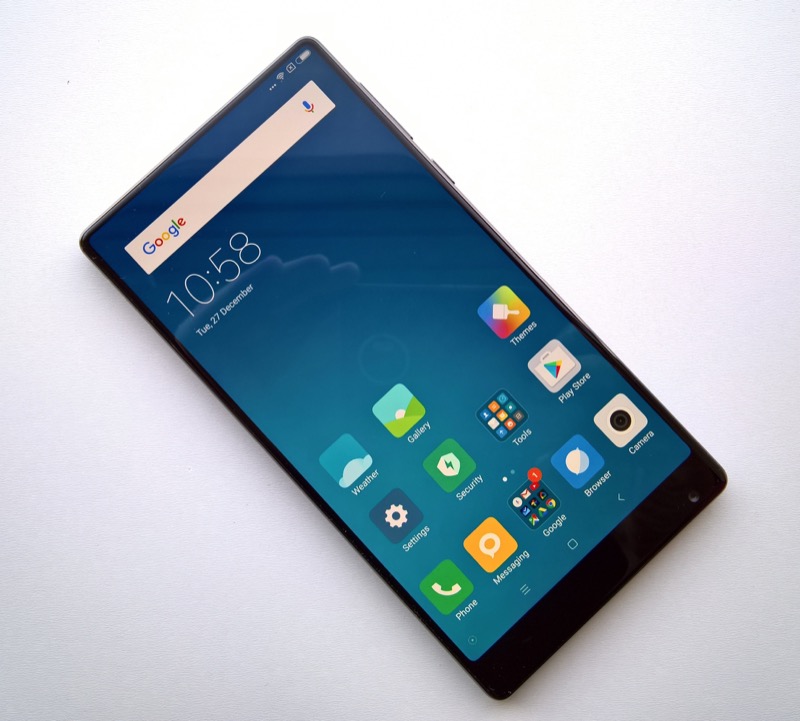
Back in October of last year, Xiaomi revealed its concept phone, the Mi Mix, with an “edgeless” display and a ceramic frame.
Over on AndroidBeat, Xiaomi’s latest concept-turned-reality has been reviewed, and while Xiaomi has obviously included plenty of noteworthy features for an edge-to-edge design, especially in a phone that boasts a 6.4-inch display, the design itself may be the phone’s biggest drawback. Xiaomi’s focus on design and “beauty,” and the inclusion of a ceramic frame, led to some slippery moments:
“There’s only one problem. Xiaomi conceived this to look beautiful, to feel beautiful, and with zero thought as to real world usability. And I’m not talking about the missing earpiece, relocated front camera or even the minimal bezels – the Mi Mix, used as-is, is a usability nightmare because it’s polished ceramic, top to toe, front to back, and edge to edge. It slides off every apparent flat surface, every resting place, it never feels secure in the hand. I found myself having to artificially wedge it on desks and kitchen surfaces twenty times a day, otherwise it would be on the floor in no time!”
The changes Xiaomi made stand out on their own, too: The front-facing camera is positioned below the display, because there’s no top bezel, which leads to some interesting video calls and Snapchat angles.
“Also moved is the front camera, here now positioned down at the bottom of the phone’s frontispiece, though in use it’s restored to the top, with a ‘first time use’ on-screen animation prompting you to rotate the phone. It’s a little clumsy and you can still make video calls with the camera at the bottom, but don’t expect your eye-line to make good contact with the other party!”

At the same time, there’s a piezoelectric speaker installed, which is aimed outwards towards your ear, but those around you will hear a caller’s words “substantially” easier than on other devices.
The review unit is actually the Mi Mix 18K, with the naming scheme focused on “the main two openings inlaid with 18 karat gold,” which also means this model is actually $300 more expensive than the other Mi Mix model, which also includes less RAM and storage.
The camera on the back is 16MP, and the review notes that while the rest of the phone, especially the model reviewed, is meant to be a premium handset, the camera might not follow suit:
“Something, as you can imagine, has to give and we have the classic 1/3″ sensor with 1 micron pixels here, i.e. pretty small, with no OIS, and wide angle optics. In good light conditions, results are more than acceptable, but in artificial and low light it all goes somewhat to pot. This may not be an issue for potential buyers of such a halo form factor, mind you – just don’t buy this for a flagship camera to match the price tag.”

Xiaomi includes a proprietary software called MIUI, which has seen plenty of love and attention over the years. This year’s implementation is over Android 6.0.1 (with an update to a version of Android 7 on the way), and it seems to be a positive experience overall. However, there isn’t an app drawer, and the pre-installed Xiaomi apps can’t be uninstalled:
“MIUI comes with an entire raft of Xiaomi built-in applications, of course. Some useful, though most becoming redundant once I’d installed the Google originals – so Contacts, Calendar, Photos, Maps, and so on. And the Xiaomi applications can’t be uninstalled, so you’d have to hide them in a suitable homescreen folder in the usual way – there’s no app drawer here, so everything lives on the homescreen panorama somewhere. This isn’t a huge issue though it does make for quite a bit of set up time for the experienced user who knows what they want to see and who wants the real Google first party applications.”

All-in-all, the review concludes that while the design has its pros and cons, the bezel-less design is likely to catch on, and it’s likely that Xiaomi is giving us a glimpse of the future:
“The Xiaomi Mi Mix is gorgeous to look at and, once configured, superb to use, with high spec components throughout, camera permitting (for space reasons). As Unique Selling Points go, having almost zero bezels on three sides comes pretty high on the list and I wouldn’t be at all surprised to see more and more smartphones come with similar designs in 2017. Imagine a phone with a 5.5” display in the body of what normally houses a 5” screen. Oh wait, such a Mi Mix ‘nano’ is already rumoured from Xiaomi – but they won’t be alone here. All I’m asking, aside from a properly thought out ‘world edition’ in terms of updates, bands and regions, is that the polished ceramic finish be dialled down somehow – smartphones don’t need to also be works of art!”
You can check out the full review through the source link below. What do you think? Are minimal bezels the way to go?
[via AndroidBeat]